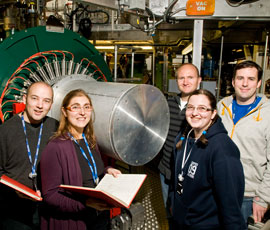
The experimental team (left to right): Alan Drew, Laura Nuccio, Leander Schulz (Univ. Fribourg), Maureen Willis and Iain Mckenzie (ISIS)
Known as High Field muon spectrometer, or HiFi, the new machine has the ability to produce magnetic fields of 5 Tesla - 80,000 times stronger than the earth's magnetic field - and temperatures down to minus 272.95 degrees centigrade - within 0.02 degrees of absolute zero.
Dr Alan Drew and his colleagues from Queen Mary's Condensed Matter Physics research group are using HiFi to explore the electronic properties of organic semiconductor materials, which are tipped as the "next generation" of flat screen TVs and mobile phone displays.
Dr Drew explains; "At ISIS, we create particles called muons, which are usually only found in cosmic radiation. Using a beam of muons and the HiFi's super capabilities, we probe organic semiconductor materials on a microscopic scale, hoping to better understand the physics of superconductivity, magnetism and how semiconductors conduct."
HiFi has been built over the past four years with funds provided by the UK Science and Technology Facilities Council Facility Development Programme. "The instrument is proving to be a very sensitive tool, and is performing extremely well," says Dr Drew.

